Latest blogs and articles
Leading you to a better financial future.

What a Wealthy Person’s Tax Return Looks Like
What a Wealthy Person’s Tax Return Looks Like
Taxes are unavoidable, but for the wealthiest individuals, they often pay lower rates thanks to investment strategies like passive income. Let's dive into what passive income entails, how it differs from active income, and why it leads to lower taxes for the wealthy.
Passive Income
Since passive income will serve as the basis for this entire article, we would start from it. So what is passive income? Passive income is income that one does not actually participate in—basically, it is unearned income. Passive income is usually derived from rental real estate.
Examples of passive income are rental properties—this range from long-term rentals to short-term rentals. You can also get passive income from being a silent partner in a business like a hair salon. Now that you have gotten the hang of passive income, let's discuss briefly on active income.
Active Income
Active income (also known as earned income) is a salaried income from rendering service for an agreed-upon task. There are a lot of examples of active incomes, such as getting a salary, allowance, or commission for jobs completed within a specific time frame.
One thing that stands out for active income is that you need actual participation, such as worked hours. So, that check your employer gives you weekly or monthly is an example of active income. Also, if you are self-employed, your income falls under active income.
As we have understood active and passive income, it's time for us to look at the key difference in taxation and how the wealthy ones navigate it.
Active and Passive Income - Taxation
A key distinction for active income is how much it is taxed! Essentially, if you are an active income earner, you will get to pay tax on FICA (Medicare and Social Security), which is around 7.65% and 15.3% for self-employed.
This is where passive income edges out active income, as there is no FICA tax of any kind. In addition, people who earn passive income can further reduce any tax that they get from their passive gain returns. This is where wealthy people take advantage of passive gains.
How do wealthy people use passive income to their advantage?
This is where it gets a little interesting. Wealthy people who own rentals offset their taxes with passive loss and deductions such as repairs, property management fees, property taxes, and depreciation.
See how it happens. Imagine you have three long-term rentals that will make a total of $100,000 in a year. If you leave this be, you will be subject to taxes. So, what should you do? They find depreciation worth $100,000 and start asking themselves how much property they will need to buy in order to create the depreciation. And just like that, there is little to no more tax.
One thing worthy of note is how this way of offsetting your tax makes wealthy people invest more, which can increase their wealth. This leads us to another strategy that is used to reduce tax in passive income: 1031 exchange strategy.
1031 exchange strategy
The 1031 exchange offers a tax-saving opportunity by allowing you to defer capital gains tax when you sell a property and reinvest the proceeds into another property of equal or greater value within a specific time frame.
For instance, if you bought a property for $100,000 and it's now worth $6,000,000, your capital gain is $5.9 million. By reinvesting this entire amount into another property through a 1031 exchange, you can defer taxes on the gain.
However, if you can't find a suitable property within the timeframe, you can purchase any property with the capital gain and put it into service to generate tax losses. If this doesn't cover the entire gain, you can seek additional properties to invest in. The goal is to balance passive gains with passive losses to optimize tax benefits.
How to convert active income to passive income?
As we have seen, having passive income comes with a lot of advantages, such as lower taxes and more expendable income. So, if you have active income and are looking for ways to transfer it to passive income, use these tips.
Have a clear and defined plan: If you have decided that you want to start investing so you can get money passively; you need a clear path. What do you want to invest in? What type of real estate do you want to invest in? How much do you know about investing? What is your exit strategy from your current active income job? Asking yourself questions like these would give you an idea of what you want.
Start small: The goal is passive income is to have as close to 100% of your active income transferred to passive. But this doesn't happen immediately; know that it is a gradual process. Start from 5%, then 10%, and go higher. Allow yourself to learn from it and grow.
Do enough research: Knowledge is power. Do as much research as possible about whatever investment you want. Listen to podcasts, read books, watch videos and ask questions in areas relating to your interest.
Conclusion
Wealthy people understand the power of passive income and low taxation, and you should do too. So, start finding ways you can move to passive income so you can fully explore all your options.
What a Wealthy Person's Tax Return Looks Like
Join my Facebook group with over 9,000 real estate investors!

Choose Your Journey to Tax Excellence
Journey 1
Building a Tax Advisory & Consulting Practice
Scale, streamline, and systemize your advisory business.
Turn compliance clients into year-round advisory opportunities while mastering operational efficiencies for sustainable growth. This track covers pricing, hiring, marketing, and client engagement essentials to help you build a practice you love.
WHAT YOU’LL LEARN:
Crafting solid engagement letters and pricing models.
Transforming compliance clients into year-round
partners.
Marketing
strategies that drive consistent growth.
Recruiting and training the right team to scale your business.
Bonus:A Power Checklist for the ultimate year-end tax planning session.
Journey 2
Tax and Legal Foundations: Core Strategies for All Levels
Master the fundamentals that drive financial success.
Perfect for business owners and advisors, this track delivers essential insights on asset protection, tax planning, estate strategies, and IRS compliance.
WHAT YOU’LL LEARN:
Unlock estate planning with Revocable Living Trusts.
Maximize retirement savings through Solo 401(k) plans.
Real estate strategies: Short-term, long-term, and self-rentals.
Learn asset protection that actually works.
Navigate IRS resolution with confidence and ease.
Journey 3
Advanced Insights: Unlock Complex Tax Strategies
Top-tier strategies for high-value clients.
Designed for experienced professionals, this track offers in-depth guidance on prime tax strategies, entity structuring, and payroll solutions. Gain the insights needed to handle complex business scenarios with confidence.
WHAT YOU’LL LEARN:
Report multi-entity structures with Forms 1065 & 1120S.
Maximize tax savings using Bonus Depreciation & Section 179.
Seamlessly relocate clients to tax-free states.
Navigate business sales and acquisitions smoothly.
Use 105 Plans to save clients on healthcare costs.

2024 Learn Like A CPA. All rights reserved.